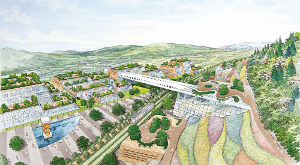 |
 |
|||||||||||||
|
|||||||||||||
|
|||||||||||||
|
What will happen when the ILC is built? One hopes discoveries will change the way we see the universe. It will answer the questions about what the universe is made of. And maybe it will help generate new Nobel Prize winners... “OK, I understand that something great will happen in the academic world. But I don't really get it,” some people might think. For these people, a symposium based on a recent study was held to explain what the city will be like if the ILC gets built at Mizusawa, Iwate prefecture, one of the two ILC candidate sites in Japan. This study was done by Michio Kitamura, senior consultant of Nomura Research Institute Ltd., Japan's largest consulting firm, and Ryoichi Ishii of Nomura Agri Planning & Advisory Co. Ltd., which specialises in the research and analysis of needs in the agricultural industry. “This is only a tentative study made only for this symposium, so please regard it as a material for a discussion,” repeated Kitamura several times through his talk. But it was just enough information for possible future neighbours of the ILC to have an idea of how the city would transform. Kitamura defined the future ILC city as an "international science research city". There are many cities of this kind around the world. Kitamura categorised those cities from different standpoints: the initial city formation, the field of research or industry, and its size. For instance, the Japanese city of Tsukuba, where KEK is located, was formed under a national policy. Other science cities can be formed by regional governments' initiatives, or industries. As another example, a medical-industry development project is restoring the economy of the city of Kobe by developing a cluster of medical-related industries. The cities that are rather compact – a couple of hundred thousand square metres, like Taiwan's silicon valley, Hsinchu – are categorised as 'district type.' Ten to 100 times larger cities such as Sophia Antipolis, a technology park northwest of Antibes and southwest of Nice, France, belong to the 'regional type', and much larger cities or counties are categorised as 'sphere type', such as San Diego, the heart of biotechnology in the US. Cities can also be categorised by the R&D or production network: domestic or international. Kitamura's analysis showed that the ILC city could be formed by enticing the regional government. “Of course, big projects like the ILC have to be defined under national policy, too. But if there is no interest or understanding by the people who reside in the construction area, there won't be a city,” Kitamura said. The core facility will be, of course, the ILC. But the branches of laboratories of other countries and national and international universities will also form clusters. The field of research of the ILC city will be particle physics, a basic science. Therefore, one cannot expect prompt and direct enticement. “Still, the ILC needs numerous advanced technologies and techniques, such as civil engineering, surface treatment technology, or high-precision processing technology. Companies providing such services might also settle in the area.” There are possibilities that the R&D for the technologies using accelerators, such as medical treatments, will also be carried out in the city. “Obviously, the network will be international. I suppose that in the initial state, the size of the city will be district-level. But it will grow bigger: as big as Tsukuba Science City,” said Kitamura. The ILC city would not only be a place for research and industry. It would also be the home for researchers, engineers and their families from around the world. It is crucial to develop a comfortable and safe environment for people who live and work there. It would be absolutely necessary to improve the access to and from international airports and the transportation network. The city would also need to provide high-speed communication infrastructures for both research and private life. The residence or accommodation facilities should match international standards. The medical services, education, or administration services need to support many languages. “In addition to those necessities, you must consider providing personal services, such as proper religious environments, or even TV programmes from home countries. There are so many things to consider in building an international city,” said Kitamura. He concluded his talk by giving a rough number of the economic impact of the ILC. “It will be at least a 5.2-trillion yen economic impact, which is the calculated total of direct economic benefits and economic knock-off effects in the first ten years from the beginning of the construction. But as I said, this is a tentative number. I need to make further studies to make more precise calculations,” said Kitamura. “You will need to formulate a clear vision and strategy, and plan to implement that vision to build a successful international science research city as soon as possible.” Ishii, who specialises in agrarian policy, said, “With a concrete strategy, living in ILC city could become an ideal life style, integrating residential environment and advanced technology.” -- Rika Takahashi |
|||||||||||||
| © International Linear Collider |
